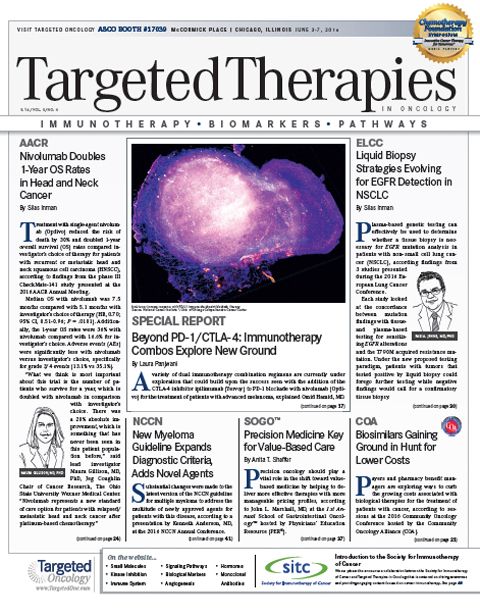Neoadjuvant T-DM1/Pertuzumab Effective in I-SPY 2 Trial for HER2-Positive Breast Cancer
The combination of T-DM1 and pertuzumab was superior to the combination of paclitaxel and trastuzumab as neoadjuvant treatment for women with HER2-positive breast cancer.
Angela DeMichele, MD
The combination of T-DM1 (ado-trastuzumab emtansine; Kadcyla) and pertuzumab was superior to the combination of paclitaxel and trastuzumab as neoadjuvant treatment for women with HER2-positive breast cancer, according to an analysis the adaptively randomized I-SPY 2 Trial.
The goal of the I-SPY 2 trial was to identify drugs and combinations of drugs to further explore in phase III trials. A drug or combination "graduates" by reaching a threshold predictive probability of success in a subsequent phase III trial. Based on the findings from the study, the T-DM1 combination should now advance into a phase III study, said Angela M. DeMichele, MD, at the 2016 AACR Annual Meeting.
The toxicity profiles favored the T-DM1/pertuzumab combination versus paclitaxel/trastuzumab, with hypertension, neuropathy, and alopecia occurring much less frequently in patients assigned to T-DM1/pertuzumab. "I would argue that these are side effects of treatment that really matter to women, that can really affect their day-to-day function," said DeMichele, professor of medicine and epidemiology, University of Pennsylvania, Philadelphia.
Paclitaxel plus trastuzumab has demonstrated improved outcomes in HER2-positive breast cancer compared with chemotherapy alone, and it is considered a standard treatment in this setting. A pCR at the time of surgery is an excellent surrogate for long-term survival outcomes in HER2-positive breast cancer. I-SPY 2 tested the ability of T-DM1 plus pertuzumab to improve pCR rates over standard therapy.
I-SPY 2 has numerous simultaneously running experimental arms in which therapies are matched with breast cancer subtypes based on hormone receptor (HR) status and the cancer's profile on the MammaPrint 70-gene signature. The branch of I-SPY 2 presented at AACR included patients with HER2-positive advanced breast cancer>2.5 cm and adequate organ function and performance status.
In the study, patients were randomized to control (paclitaxel, 80 mg/m2, plus trastuzumab, 4 mg/kg followed by 2 mg/kg, both given weekly for 12 doses) or T-DM1 (3.6 mg/kg) plus pertuzumab (840-mg load followed by 420 mg) both administered every 3 weeks for four doses, or other HER2-directed arms. Upon completion, each arm proceeded to chemotherapy with doxorubicin and cyclophosphamide followed by surgery.
Overall, 1540 patients were screened for the trial; 878 met the eligibility criteria and were randomized. Of these, 249 had HER2-positive disease. One hundred sixty-five were randomized to five other investigational arms, leaving 52 who were assigned to T-DM1/pertuzumab and 32 who were assigned to paclitaxel/trastuzumab. Approximately two-thirds in each arm were HR-positive.
For all HER2-positive patients, the pCR rate in the control group was estimated at 22%, compared with 52% in the patients assigned to T-DM1/pertuzumab. "That led to a probability that T-DM1/pertuzumab was superior to [paclitaxel/trastuzumab] of 99.5%, and our probability that it would be successful in a subsequent phase III trial of 94%," said DeMichele.
HR subtypes were analyzed separately. For the HR-negative patients, the estimated pCR rate in the control arm was 33% compared with 64% in the T-DM1/pertuzumab arm, with a probability of 98% that T-DM1/pertuzumab was superior to control, and a probability of 90% that it would be successful in this subtype in a phase III trial.
Among HR-positive patients, estimated pCR rates were 17% and 46% for control and T-DM1, respectively, with a 99% probability that T-DM1/pertuzumab was superior to control in this subgroup, and a 93% probability of success in phase III.
During the experimental portion of the trial, there were very few grade 3 or 4 adverse events in either arm. For all grades of adverse events there were greater rates of hypertension (45% vs 4%), neuropathy (45% vs 0%), and alopecia (58% vs 0%) among women assigned to paclitaxel/trastuzumab compared with T-DM1/pertuzumab. As expected, elevations of alanine aminotransferase and aspartate aminotransferase levels occurred in patients randomized to T-DM1/pertuzumab “but was low grade, and not clinically signi cant,” said DeMichele.

Biomarker Testing Paves the Way for Better Targeted Therapies in NSCLC
April 16th 2024At a live virtual event, Edward S. Kim, MD, MBA, discussed the evolving landscape of biomarker testing before making treatment decisions for patients with early-stage non–small cell lung cancer (NSCLC).
Read More
Breast Cancer Leans into the Decade of Antibody-Drug Conjugates, Experts Discuss
September 25th 2020In season 1, episode 3 of Targeted Talks, the importance of precision medicine in breast cancer, and how that vitally differs in community oncology compared with academic settings, is the topic of discussion.
Listen